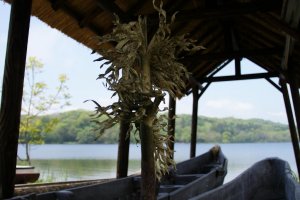The alcohol-fuelled evening the night before combined with the lack of sleep before my early morning train to Shiraoi made for a bumpy and grumpy start to my day. I was compelled forward by my interest in learning more about the traditional culture of the indigenous people of Hokkaido – the Ainu – and I wasn’t about to let a little grogginess get in my way.
I’d visited the impressive Hokkaido Museum of Northern Peoples in Abashiri and the Ainu Folklore Center at Lake Kussharo, but still wanted to see more. I’d opted for an early train anticipating that I’d catch an afternoon train back to Sapporo for a power nap before yet another night of eating and drinking my way back to recovery.
Thankfully, the train ride along the Muroran Line took just over an hour and upon arrival at Shiraoi, I was relieved that the location of the Ainu Museum Poroto Kotan was just a ten minute, one kilometer trek along the tracks moving east.
I arrived to a traditional Ainu Village on the shores of Lake Poroto and was greeted by souvenir stands and a gigantic 16 meter statue of an Ainu Chief (kotankorkur). My temporal lobe set into motion as I tried to glom onto a “travel” reference point. For those of you unfortunate enough to have visited the Polynesian Cultural Center in Hawaii, rest assured it’s nothing close to such choreographed and contrived displays. If you’ve had the good fortune of visiting the Sarawak Cultural Village in Kuching Malaysia – which I have - it is quite close to that experience. For those with neither reference points in mind, the village is a modest and moderately sized replica of a traditional Ainu Village with museum staff making traditional crafts, an educational center and traditional dance and song performances throughout the day. The admission fee for adults is ¥750 and one can expect to spend 60-90 minutes on your visit.
The village also contains a paddock of Hokkaido dogs which were taken out for walks and for the purposes of photo ops with visitors and tour groups. Unfortunately, there was also a paddock containing live bears. The bear is an important animal, in fact, the most important animal in Ainu culture but it still doesn’t negate the fact that seeing them locked up in small cages turned my stomach. The situation was exacerbated by groups of tourists purchasing biscuits from containers affixed to the outside of the cages and hurling them at the bears.
While the center did have that negative aspect, the village’s positive attributes far outweighed the “bear experience.” The traditional dance and song performance was the absolute highlight of the visit. The performance was slightly marred by a few audience members disrespectfully talking and laughing during the performance, a level of rudeness I’d not yet experienced in Japan. Perhaps it was a brief insight into an element of society that serves as a microcosm for a less than savory element of the relationship between Ainu and Non-Ainu people in Japan.
The highlight of the day, the moment that cut right through my less than ideal cognitive and physiological state was one that caught me off-guard. Staring through the lens of my camera, attempting to set the correct ISO and aperture setting I had to put the camera down. I couldn’t steady my index finger to snap a shot and the lump that had formed in my throat would not subside. An elderly Ainu woman sang a lullaby to an infant – an infant in mannequin-form no less.
Intellectually, I was completely aware that this was a song she had song many times before and even though she was holding for intents and purposes – a doll – my rational, logical mind was no match for the emotion it elicited.
Don’t begrudge the Ainu for the economic component of the souvenir stands or the posing for photos with tourists. Don’t walk through the humble village disappointed that it isn’t more extravagant. And certainly don’t go if you aren’t interested in experiencing a wonderful cultural display of traditional music, dance and storytelling.



































